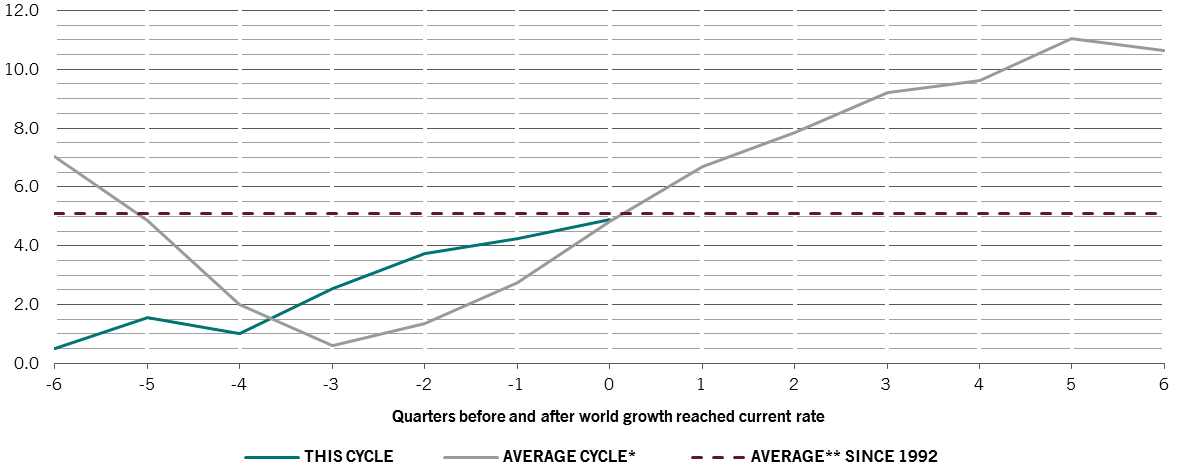A maturing global cycle boosts EM's attractions
After years of underperforming their developed rivals EM economies look set to take the lead as the global investment cycle ramps up
Emerging market economies look set to outpace the developed world after almost six years of underperformance. That’s down to a profound change in the dynamics of the business cycle. With investment set to supplant consumption as the main engine of economic growth, EM countries should benefit most from the trade boost that comes with rising capital spending.
Global consumption growth has jumped in the past year after being in the doldrums for the previous five and is now 0.9 standard deviations above its long-term average. Meanwhile, consumer sentiment is at its strongest in more than quarter of a century. This suggests that there’s not much scope for consumer spending to drive the world economic expansion further.
But if the consumption cycle is near its peak, the investment cycle is still in its infancy. Having bottomed out in the first quarter of 2016, it started to pick up in the third quarter and was rising at a 3.3 per cent annual pace by mid-2017. What’s more, survey data suggest investment growth is accelerating further as existing capacity is absorbed and as corporate profitability grows.
Stronger investment goes hand in hand with stronger exports. For the past six years real exports have grown at below their long-term average. Yet after a trough in October 2016, they are now in the ascendancy again. That makes sense because investment is trade intensive – expensive machinery tends to be sourced on the international market.
Quarterly trade growth, year on year percentage change, current cycle compared to average rate and to the profile of previous cycles*

The current cycle looks most similar to the ones in 1993, 1999 and 2002. If those prove to be a precedent, then world trade is likely to accelerate during the next five quarters, peaking at an annual growth rate of some 11 per cent compared to just over 4 per cent now.
Trade, in turn, tends to amplify global economic activity. And because emerging markets are more sensitive to trade than their developed counterparts – a 1 per cent increase in cross-border flows lifts EM economic output by 0.26 percentage points but by only 0.14 percentage points for developed markets, according to our models – they are likely to be the key beneficiaries of this upswing.
This has major implications for financial markets. First, EM currencies should continue to appreciate against the US dollar. Second, EM equities’ price to book ratios are likely to increase relative to those of their developed market peers. And, finally, EM value companies can at long last be expected to do better than EM growth stocks, having underperformed since 2011.
The global economic cycle may be getting on, but that’s no reason to fear its imminent demise. And well-positioned EM investors are particularly likely to benefit.
Important legal information
This marketing material is issued by Pictet Asset Management (Europe) S.A.. It is neither directed to, nor intended for distribution or use by, any person or entity who is a citizen or resident of, or domiciled or located in, any locality, state, country or jurisdiction where such distribution, publication, availability or use would be contrary to law or regulation. The latest version of the fund‘s prospectus, Pre-Contractual Template (PCT) when applicable, Key Information Document (KID), annual and semi-annual reports must be read before investing. They are available free of charge in English on www.assetmanagement.pictet or in paper copy at Pictet Asset Management (Europe) S.A., 6B, rue du Fort Niedergruenewald, L-2226 Luxembourg, or at the office of the fund local agent, distributor or centralizing agent if any.
The KID is also available in the local language of each country where the compartment is registered. The prospectus, the PCT when applicable, and the annual and semi-annual reports may also be available in other languages, please refer to the website for other available languages. Only the latest version of these documents may be relied upon as the basis for investment decisions.
The summary of investor rights (in English and in the different languages of our website) is available here and at www.assetmanagement.pictet under the heading "Resources", at the bottom of the page.
The list of countries where the fund is registered can be obtained at all times from Pictet Asset Management (Europe) S.A., which may decide to terminate the arrangements made for the marketing of the fund or compartments of the fund in any given country.
The information and data presented in this document are not to be considered as an offer or solicitation to buy, sell or subscribe to any securities or financial instruments or services.
Information, opinions and estimates contained in this document reflect a judgment at the original date of publication and are subject to change without notice. The management company has not taken any steps to ensure that the securities referred to in this document are suitable for any particular investor and this document is not to be relied upon in substitution for the exercise of independent judgment. Tax treatment depends on the individual circumstances of each investor and may be subject to change in the future. Before making any investment decision, investors are recommended to ascertain if this investment is suitable for them in light of their financial knowledge and experience, investment goals and financial situation, or to obtain specific advice from an industry professional.
The value and income of any of the securities or financial instruments mentioned in this document may fall as well as rise and, as a consequence, investors may receive back less than originally invested.
The investment guidelines are internal guidelines which are subject to change at any time and without any notice within the limits of the fund's prospectus. The mentioned financial instruments are provided for illustrative purposes only and shall not be considered as a direct offering, investment recommendation or investment advice. Reference to a specific security is not a recommendation to buy or sell that security. Effective allocations are subject to change and may have changed since the date of the marketing material.
Past performance is not a guarantee or a reliable indicator of future performance. Performance data does not include the commissions and fees charged at the time of subscribing for or redeeming shares.
Any index data referenced herein remains the property of the Data Vendor. Data Vendor Disclaimers are available on assetmanagement.pictet in the “Resources” section of the footer. This document is a marketing communication issued by Pictet Asset Management and is not in scope for any MiFID II/MiFIR requirements specifically related to investment research. This material does not contain sufficient information to support an investment decision and it should not be relied upon by you in evaluating the merits of investing in any products or services offered or distributed by Pictet Asset Management.
Pictet AM has not acquired any rights or license to reproduce the trademarks, logos or images set out in this document except that it holds the rights to use any entity of the Pictet group trademarks. For illustrative purposes only.

